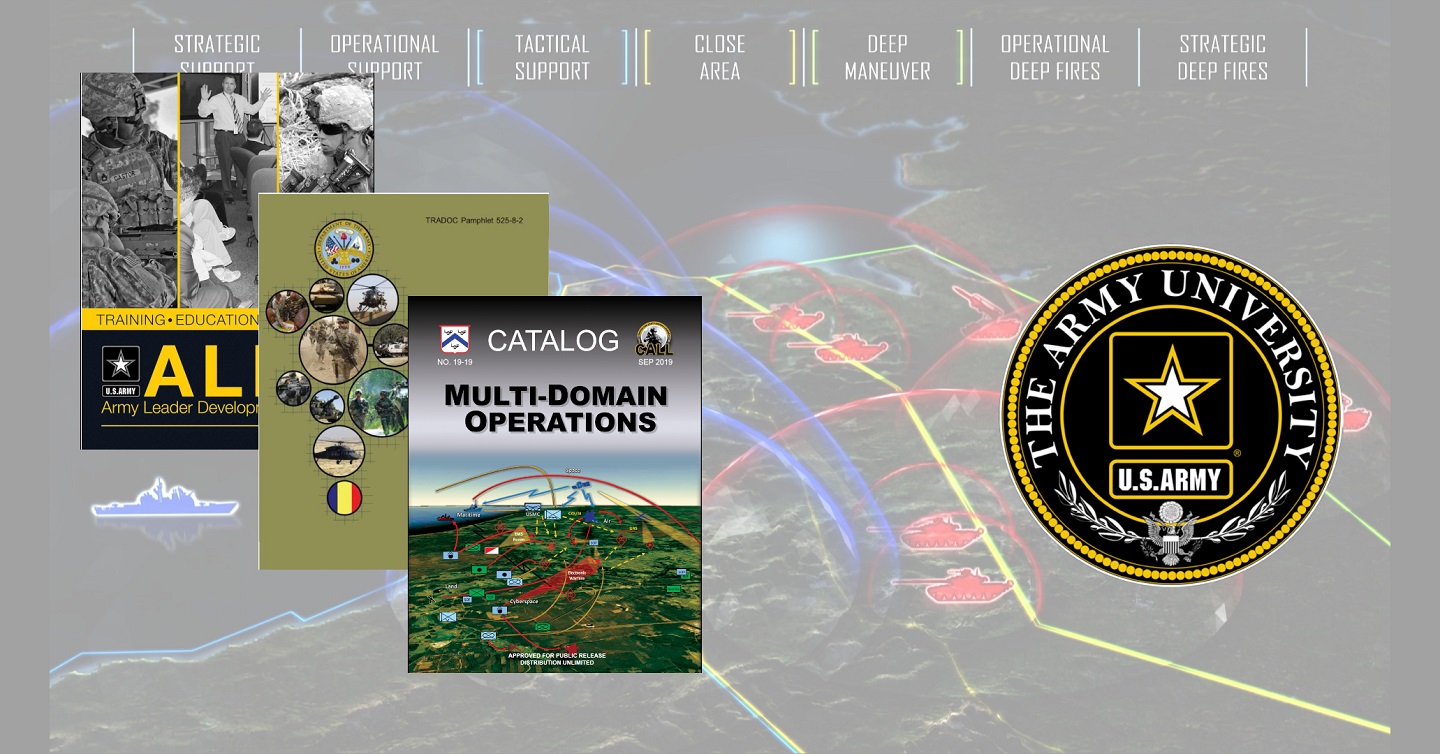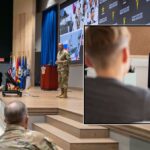
Land, sea, air, space, and cyberspace, that is the multi-domain environment that the Army sees operations occurring in from now forward. What does this shift in viewing the environment mean for all the aspects of raising and sustaining an army and all of its interactions and interdependencies in the joint force? Doctrine is being written and re-written across the force to adapt to this new schema, but all the doctrine in the world is useless if there aren’t leaders in place that understand it and execute it. Jeff Barta joins podcast editor Ron Granieri in the virtual studio to talk about the efforts of Army University to change, synchronize, modernize and distribute the education and training necessary to develop the leaders of today and tomorrow to operate in the multi-domain environment.
When I was looking through some of the documents, I found that the Army University was the most significant change to the structure of leader development since the creation of the Training and Doctrine Command back in the late seventies.
Podcast: Download

Jeff Barta was recently promoted to Colonel and now serves on the U.S. European Command Operations Staff. He is a Husband, Father, and Armor Officer who has served in a variety of Armor, Cavalry, Infantry, and Training assignments. He may be reached on Twitter @jeffjbarta.
Ron Granieri is an Associate Professor of History at the U.S. Army War College and the Editor of A BETTER PEACE.
The views expressed in this presentation are those of the speakers and do not necessarily reflect those of the U.S. Army War College, U.S. Army, or Department of Defense.
Photo Credit: Background image from video capture by William Norris.





A central underlying problem for the U.S./the West — re: its multi-domain operations concept — this may be that the U.S./the West (see my Part I below) would not seem to be placing their emphasis on the same “domain” that our near-peer and other opponents (see my Part II below) are, for example, as described here:
Part I: The Domains (Land, Air, Maritime, Space and Cyberspace) that the U.S./the West Would Seem to be Concentrating On:
“What Are Multi-Domain Operations
(MDO)?
According to the U.S. Army’s Training and Doctrine Command (TRADOC):
— Multi-Domain Operations describe how the U.S. Army, as part of the joint force [Army, Navy, Air Force, and Marines] can counter and defeat a near-peer adversary capable of contesting the U.S. in all domains [air, land, maritime, space, and cyberspace] in both competition and armed conflict. The concept describes how U.S. ground forces, as part of the joint and multinational team, deter adversaries and defeat highly capable near-peer enemies in the 2025-2050 timeframe. MDO provides commanders numerous options for executing simultaneous and sequential operations using surprise and the rapid and continuous integration of capabilities across all domains to present multiple dilemmas to an adversary in order to gain physical and psychological advantages and influence and control over the operational environment.”
Part II: The Domain (The Human Domain) that Our Near-Peer Opponents Would Seem to be Concentrating On:
“Why Did the Army Adopt MDO?
MDO is described in detain in a December 2018 Army publication titled The U.S. Army in Multi-Domain Operations 2028. MDO was developed in response to the 2018 National Defense Strategy, which shifted the previous focus of U.S. national security from countering violent extremists worldwide to confronting revisionist powers — primarily Russia and China — that are said to ‘want to shape a world consistent with their authoritarian model — gaining veto authority over other nations’ economic, diplomatic, and security decisions.’ According to The U.S. Army in Multi-Domain Operations 2028:
— China and Russia exploit the conditions of the operational environment to achieve their objectives without resorting to armed conflict by fracturing the U.S./’s alliances, partnerships, and resolve. They attempt to create stand-off through the integration of diplomatic and economic actions, unconventional and informational warfare (social media, false narratives, cyber-attacks), and the actual or threatened employment of conventional forces. By creating instability within countries and alliances, China and Russia create political separation that results in strategic ambiguity reducing the speed of friendly recognition, decision and reaction. Through these competitive actions, China and Russia believe they can achieve objectives below the threshold of armed conflict.”
[See the second and third major paragraphs of the Congressional Research Service document entitled “Defense Primer: Army Multi-Domain Operations updated April 22, 2021.]
Based on the information that I have provided above, the U.S./the West’s multi-domain operations; these would seem to be based on the Trump Administrations decision to formal cede the “human domain” to our near-peer and other rivals and opponents.
Why do I say this? Because:
a. While in Part I of my offering above, you will find no discussion of such things as “achieving OUR objectives without resorting to armed conflict,”
b. In Part II of my offering above, you find such things as “achieving THEIR objectives without resorting to armed conflict” as the apparent “human domain” matter that undergirds our rivals and opponents entire effort.
Bottom Line Thought — Based on the Above:
In my Part II above, the war is actually won via the “human domain” (“the people are with us!”); this, long before the fighting even starts. Conventional forces, for example as described by John Adams re: the American Revolution here, simply do “mop up:”
“As to the history of the Revolution, my Ideas may be peculiar, perhaps Singular. What do We mean by the Revolution? The War? That was no part of the Revolution. It was only an Effect and Consequence of it. The Revolution was in the Minds of the People, and this was effected, from 1760 to 1775, in the course of fifteen Years before a drop of blood was drawn at Lexington. The Records of thirteen Legislatures, the Pamphlets, Newspapers in all the Colonies ought be consulted, during that Period, to ascertain the Steps by which the public opinion was enlightened and informed concerning the Authority of Parliament over the Colonies.”
https://founders.archives.gov/documents/Jefferson/03-08-02-0560
With the Multi-Domain Operations concept, however, (a) “the people” would seem to be against us and (b) we seem to have no hope of gaining their support. Thus, it is from THIS such perspective that Multi-Domain Operations — and its emphasis on the non-human domains — was conceived?